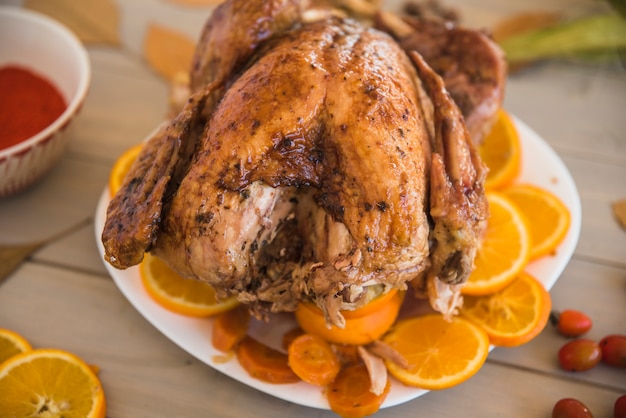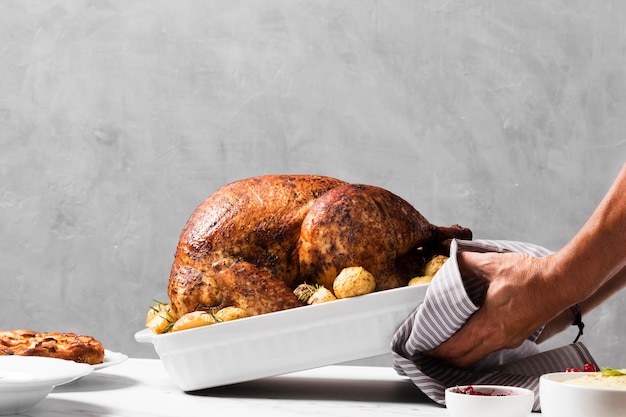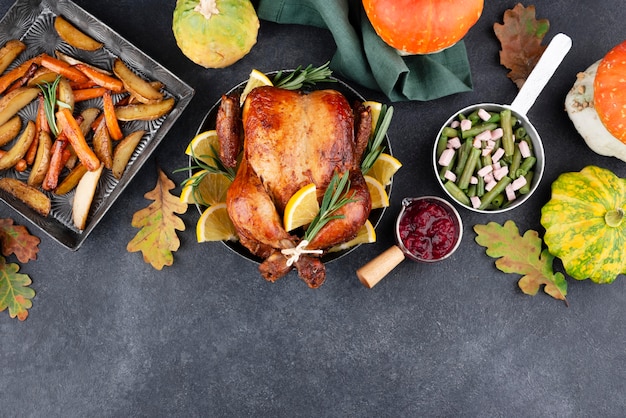There's something undeniably satisfying about a perfectly cooked turkey leg. That irresistible crispy skin, the tender, juicy meat practically falling off the bone – it's a culinary triumph that always makes my taste buds sing! As a seasoned home cook, I've spent years perfecting my turkey leg recipes, experimenting with different techniques and flavour combinations. And let me tell you, there's nothing quite like the joy of sharing a delicious turkey leg feast with friends and family.
This guide is your complete roadmap to achieving turkey leg perfection. From choosing the right leg to mastering the art of roasting, smoking, and even creating flavourful marinades and rubs, I'll share all my secrets and tips, leaving no stone unturned. So, gather your ingredients, preheat your oven, and let's embark on this delicious journey together!
(Part 1) The Turkey Leg: Your Culinary Canvas

Choosing the Right Turkey Leg: It's All About Quality
The first step to achieving turkey leg nirvana is selecting the right leg. You want a leg that's plump, with a good amount of meat and a nice, even thickness. Think of it like choosing a canvas for your culinary masterpiece - you want a solid base to work with. I typically go for legs that weigh between 1.5 and 2 pounds, as they offer a good balance of meat and bone. You can find them fresh or frozen, but I prefer fresh for that truly irresistible flavour.
Prepping the Turkey Leg: Setting the Stage for Success
Before you get down to the business of cooking, it's crucial to prep your turkey leg properly. This step helps ensure even cooking and that oh-so-desired crispy skin. Here's my tried-and-true method:
Pat it dry: Use paper towels to thoroughly dry the turkey leg, getting rid of any excess moisture. This helps the skin crisp up beautifully.
Seasoning is key: Don't be shy with the seasonings! Salt, pepper, and paprika are my go-to trio, but feel free to get creative with herbs, spices, or even a homemade dry rub. Experiment and find your perfect flavour profile.
Let it rest: Once seasoned, let the turkey leg rest in the fridge for at least an hour, allowing the flavours to meld and penetrate the meat.
(Part 2) Roasting: The Classic Technique for Turkey Leg Perfection

oven roasting: A Foolproof Method for Juicy, Crispy Results
Oven roasting is the most common way to cook turkey legs, and for good reason. It's a reliable method that delivers consistently delicious results, every time. Here's my step-by-step guide:
Preheat your oven: Start by cranking up your oven to 400°F (200°C). This high heat helps create a crispy skin and ensures even cooking.
Place the leg: Use a roasting pan or a baking sheet with a rack. This allows the hot air to circulate around the leg, ensuring it cooks evenly from all sides.
roasting time: Roast the turkey leg for about 45 minutes to an hour, or until the internal temperature reaches 165°F (74°C). You can use a meat thermometer to check the temperature accurately.
Tips for Oven Roasting: Elevate Your Turkey Leg Game
- Basting is your friend: Basting the turkey leg with melted butter or pan juices every 15 minutes helps keep the skin moist and adds a lovely layer of flavour. Think of it as giving your turkey leg a little spa treatment while it cooks.
- Rest is crucial: After roasting, let the turkey leg rest for 10-15 minutes before carving. This allows the juices to redistribute throughout the meat, resulting in a more succulent and tender leg. Patience is key here, as it truly makes a difference in the final result.
(Part 3) Smokin' Hot: The BBQ Approach for Smoky, Rich Flavors

Smoking: A Journey into Deep, Complex Flavors
For a truly unique and smoky flavour profile, consider smoking your turkey leg. It's a fantastic way to add an extra layer of complexity and a hint of rustic charm to your meal. Here's what you need to know:
Choose your wood: Hickory, pecan, and applewood are excellent choices for turkey legs, as they offer a balanced and subtle smoky flavour. You can also experiment with different woods to create unique flavour profiles.
Smoke low and slow: Smoke your turkey leg at around 225°F (107°C) for 3-4 hours, or until the internal temperature reaches 165°F (74°C). The slow, gentle smoke allows the flavours to develop and penetrate the meat.
The smoking process: Ensure your smoker is preheated and loaded with wood chips. Place the turkey leg on the smoker, making sure it doesn't touch the coals, as this can lead to uneven cooking and burning.
Tips for Smoking: Master the Art of slow cooking
- Keep an eye on the temperature: Use a meat thermometer to monitor the internal temperature throughout the smoking process. It's important to maintain a steady temperature to ensure even cooking and avoid over-smoking.
- Moisten with a glaze: Every hour or so, brush the turkey leg with your favourite barbecue glaze or sauce. This helps keep the meat moist and adds a beautiful glaze to the skin.
- Let it rest: Once smoked, let the turkey leg rest for 10-15 minutes before carving. This allows the juices to redistribute, ensuring a truly tender and juicy result.
(Part 4) Beyond the Basics: Getting Creative with Flavours
Flavour Infusion: The Art of Marinades and Rubs
Don't be afraid to get creative with your turkey leg flavouring! A marinade or dry rub can take your dish from ordinary to extraordinary. Here are some ideas to spark your imagination:
Marinade Recipes: A Symphony of Flavors
- Citrus and Herb: Combine orange juice, lemon juice, olive oil, garlic, rosemary, thyme, and salt and pepper. Marinate for 2-4 hours for a bright and refreshing flavour.
- Honey-Soy: Mix honey, soy sauce, ginger, garlic, and sesame oil. Marinate for at least 4 hours, or overnight for maximum flavour. This marinade delivers a sweet and savory punch that is both delicious and addictive.
- Spicy Mango: Blend mango, habanero pepper, lime juice, cumin, and coriander. Marinate for 2-4 hours for a tantalizing blend of sweet, spicy, and tangy notes.
Dry Rub Recipes: A Burst of Flavor
- Cajun Spice: Combine paprika, cayenne pepper, garlic powder, onion powder, oregano, thyme, and salt and pepper. This rub brings a bold and fiery flavour to your turkey leg.
- BBQ Rub: Mix brown sugar, paprika, garlic powder, onion powder, smoked paprika, black pepper, and chili powder. A classic barbecue rub that adds a sweet, smoky, and savory flavour.
- Herby Blend: Combine dried rosemary, thyme, oregano, sage, garlic powder, onion powder, salt, and pepper. A fragrant and aromatic blend of herbs that will elevate your turkey leg to new heights.
(Part 5) The Perfect Sidekick: Accompanying Dishes for a Complete Feast
side dishes: The Perfect Complements to Your Turkey Leg
No turkey leg feast is complete without a delicious array of side dishes to round out the meal. Here are some of my personal favourites:
mashed potatoes: Classic and comforting, mashed potatoes are the perfect complement to a juicy turkey leg. They offer a creamy texture and a comforting warmth that perfectly balances the savory richness of the turkey leg.
Roasted Vegetables: Seasoned with herbs and spices, roasted vegetables like carrots, broccoli, or Brussels sprouts add a touch of colour and freshness to your meal. They offer a contrasting texture and a burst of flavour.
Cornbread: A touch of sweetness and texture, cornbread is a fantastic addition to a turkey leg feast. Its crumbly texture and slight sweetness create a lovely contrast to the savory turkey leg.
Coleslaw: Tangy and refreshing, coleslaw helps balance the richness of the turkey leg. Its crispness and tangy flavour add a delightful contrast to the richness of the turkey leg.
(Part 6) Serving Up Perfection: Plating and Presentation for a Memorable Meal
Presentation Matters: Making a Lasting Impression
A beautifully plated turkey leg can make a real impression on your guests. Here are some tips to elevate your dish from delicious to downright stunning:
Carve the leg: Use a sharp knife to carve the turkey leg, removing the bone and separating the meat into bite-sized pieces. This makes it easy for guests to enjoy the succulent meat.
Plate with care: Arrange the carved turkey leg on a platter, alongside your chosen side dishes. Create an attractive arrangement that highlights the deliciousness of each element.
Garnish with finesse: Add a touch of elegance by garnishing your platter with fresh herbs, sliced lemons, or a drizzle of sauce. A simple garnish can elevate the visual appeal and add a final touch of flavour.
(Part 7) turkey leg leftovers: No Waste Allowed!
Make the Most of Leftovers: Creative Ways to Repurpose Deliciousness
Don't let those delicious turkey leg leftovers go to waste! Here are some creative ways to repurpose them for a variety of meals:
Turkey Leg Salad: Combine chopped turkey leg meat with your favourite salad ingredients like lettuce, tomatoes, and cucumbers. A fresh and flavorful way to enjoy leftover turkey leg.
Turkey Leg Soup: Add leftover turkey leg meat to a hearty soup for an extra boost of flavour. Perfect for a comforting meal on a chilly day.
Turkey Leg Sandwiches: Slice leftover turkey leg meat and use it to create delicious sandwiches. A quick and easy way to enjoy leftover turkey leg.
(Part 8) FAQs: Your Turkey Leg Questions Answered
Q: How long should I cook a turkey leg in the oven?
A: The cooking time for a turkey leg depends on its size and your chosen cooking method. On average, a 1.5-2 pound turkey leg will take 45-60 minutes to roast in a 400°F (200°C) oven. However, it's essential to use a meat thermometer to ensure the internal temperature reaches 165°F (74°C) for safe consumption. Always err on the side of caution and check the temperature frequently.
Q: What are some good seasonings for turkey legs?
A: Salt, pepper, paprika, garlic powder, onion powder, herbs like rosemary, thyme, oregano, and sage are all excellent choices for turkey legs. You can also experiment with dry rubs, marinades, or barbecue sauces to add a burst of flavour. Don't be afraid to experiment and find your signature blend!
Q: How do I know if my turkey leg is done?
A: The best way to determine if your turkey leg is cooked through is to use a meat thermometer. It should reach an internal temperature of 165°F (74°C). The skin should also be golden brown and crispy. If the skin is not crispy enough, you can broil it for a few minutes to achieve that perfect crunch.
Q: What can I serve with turkey legs?
A: Turkey legs pair well with a variety of side dishes, including mashed potatoes, roasted vegetables, cornbread, coleslaw, rice, and pasta salad. Choose sides that complement the flavour profile of your chosen turkey leg recipe. For a complete and balanced meal, consider serving a combination of starchy, vegetable, and/or salad-based sides.
Q: Can I freeze leftover turkey legs?
A: Yes, you can freeze leftover turkey legs for up to 3 months. Wrap them tightly in plastic wrap or freezer paper and store them in the freezer. Defrost them in the refrigerator overnight before reheating. Freezing leftover turkey legs is a great way to save time and have a delicious meal ready in no time.
(Part 9) Conclusion: The Magic of Turkey Legs
The journey of cooking a turkey leg is more than just a recipe; it's an experience. From selecting the perfect leg to creating a symphony of flavors and sharing a delicious meal with loved ones, every step is a celebration of culinary artistry.
Remember, don't be afraid to experiment, have fun, and embrace the magic of turkey legs. May your next turkey leg adventure be filled with deliciousness and joyful memories.
Everyone is watching

Prime Rib Roast Cooking Time Chart: Per Pound Guide
Cooking TipsPrime rib roast. Just the name conjures images of lavish dinners, crackling fires, and hearty laughter. It’s ...

How Long to Bake Potatoes in the Oven (Perfect Every Time)
Cooking TipsBaked potatoes are a staple in my kitchen. They're incredibly versatile, delicious, and surprisingly easy to m...

Perfect Rice Every Time: The Ultimate Guide to Cooking Rice
Cooking TipsAs a self-proclaimed foodie, I've always been a bit obsessed with rice. It's the foundation of countless cuisi...

The Ultimate Guide to Cooking Asparagus: Tips, Techniques, and Recipes
Cooking TipsAsparagus. The mere mention of this spring delicacy conjures up images of vibrant green spears, crisp and burs...

Ultimate Guide to Cooking the Perfect Thanksgiving Turkey
Cooking TipsThanksgiving. Just the word conjures up images of overflowing tables laden with delicious food, the scent of r...
